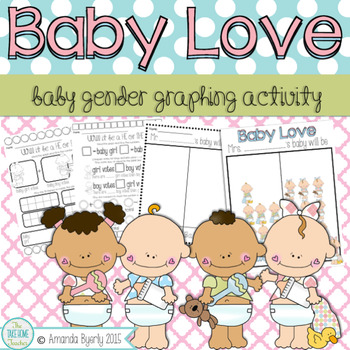BABY LOVE baby gender graph activity
Take Home Teacher
1.2k Followers
Resource Type
Standards
CCSSK.CC.A.3
CCSS1.MD.C.4
CCSS2.MD.D.10
CCSS3.MD.B.3
CCSSK.NBT.A.1
Formats Included
- PDF
Pages
30 pages
Take Home Teacher
1.2k Followers
Description
Expecting a new bundle of joy in your house? Share the excitement with your students!
Common Core aligned math activities for Pre-K to 3rd grade.
* directions & polling options
* colorful class graph materials
* B/W individual graphing pages & results analysis page for each
grade level.
* various graph title (Mrs., Mr., or Ms.) and baby ethnicity options.
Happy pregnancy to all those hard-working teachers/parents.
Total Pages
30 pages
Answer Key
Does not apply
Teaching Duration
N/A
Report this resource to TPT
Reported resources will be reviewed by our team. Report this resource to let us know if this resource violates TPT’s content guidelines.
Standards
to see state-specific standards (only available in the US).
CCSSK.CC.A.3
Write numbers from 0 to 20. Represent a number of objects with a written numeral 0-20 (with 0 representing a count of no objects).
CCSS1.MD.C.4
Organize, represent, and interpret data with up to three categories; ask and answer questions about the total number of data points, how many in each category, and how many more or less are in one category than in another.
CCSS2.MD.D.10
Draw a picture graph and a bar graph (with single-unit scale) to represent a data set with up to four categories. Solve simple put-together, take-apart, and compare problems using information presented in a bar graph.
CCSS3.MD.B.3
Draw a scaled picture graph and a scaled bar graph to represent a data set with several categories. Solve one- and two-step “how many more” and “how many less” problems using information presented in scaled bar graphs. For example, draw a bar graph in which each square in the bar graph might represent 5 pets.
CCSSK.NBT.A.1
Compose and decompose numbers from 11 to 19 into ten ones and some further ones, e.g., by using objects or drawings, and record each composition or decomposition by a drawing or equation (e.g., 18 = 10 + 8); understand that these numbers are composed of ten ones and one, two, three, four, five, six, seven, eight, or nine ones.





